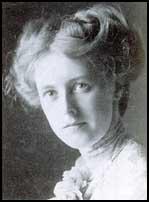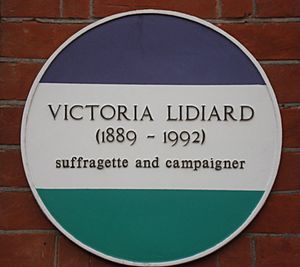Victoria Lidiard facts for kids
Quick facts for kids
Victoria Lidiard
|
|
|---|---|
 |
|
| Born |
Victoria Simmons
23 December 1889 Bristol, England
|
| Died | 3 October 1992 (aged 102) Hove, England
|
| Nationality | British |
Victoria Lidiard (1889–1992) was a British woman who worked hard for social causes. She was an optician and wrote Christian books. Many people believe she was the longest-living suffragette in the UK. Suffragettes were women who fought for the right to vote.
Contents
Early Life and Education
Victoria Simmons was born on December 23, 1889, in Clifton, Bristol, England. She grew up in a very large family with 12 brothers and sisters. Victoria went to a local school called a Dame school. When she was 14, she started working in a photo studio. In the evenings, she studied bookkeeping and shorthand to learn useful office skills.
Fighting for Women's Rights
Joining the Suffragettes
In 1907, Victoria and her mother and sisters joined the Women's Social and Political Union (WPSU). This group was very important in the fight for women's right to vote. They joined after hearing Annie Kenney, a leader from the WPSU, speak. Victoria's father did not agree with their decision.
Victoria quickly became an active member in her local area. She gave speeches, like one at Bristol Docks. She also sold the WPSU newspaper, Votes for Women. She took part in peaceful protests, such as writing slogans with chalk around Clifton. She also helped to interrupt political meetings to make sure people heard their message.
Taking Stronger Action
At first, Victoria was not sure about the WPSU's more forceful protests. These actions were supported by leaders like Emmeline Pankhurst. However, Victoria later joined in some of these protests.
- On March 1, 1908, she may have been part of a protest where windows were broken in London's shopping areas. These included Regent Street, Piccadilly, the Strand, Oxford Street, and Bond Street.
- On March 4, 1912, she definitely took part in a protest in Whitehall. During this protest, she broke a window at the War Office. She was arrested and sent to Holloway Prison for two months.
Life During and After World War I
Wartime Work
During World War I, the WPSU stopped its protests. Victoria and one of her sisters managed a guest house in Kensington. Victoria also spent her weekends working at Battersea Power Station. There, she helped to put together anti-aircraft shells for the war effort.
Marriage and Career
In 1918, Victoria married Alexander Lidiard. He was a major in the 3rd Manchester Rifles battalion. Alexander was also a member of the Men's League for Women's Suffrage, which supported women's right to vote.
After the war, Victoria trained to become an optician. She and her husband then opened and ran optician practices in Maidenhead and High Wycombe.
Later Life and Activism
Victoria Lidiard remained active in social causes throughout her life. She was involved in many different areas:
- She campaigned for better conditions for animals, especially how livestock were transported.
- She held positions on her local church council.
- She was a member of the National Council.
Towards the end of her life, she worked with the Movement for the Ordination of Women. This group wanted women to be allowed to become priests in the church. Victoria saw this work as very similar to her early efforts for women's right to vote.
Published Works
Victoria Lidiard also wrote and published two books:
- Christianity, Faith, Love and Healing (1988)
- Animals and All Churches (1989)
Legacy
Victoria Lidiard passed away in Hove, East Sussex, on October 3, 1992. Because she was one of the longest-living suffragettes, the BBC interviewed her near the end of her life. Her life and work are remembered with a special blue plaque in Hove.
See also
 In Spanish: Victoria Lidiard para niños
In Spanish: Victoria Lidiard para niños


